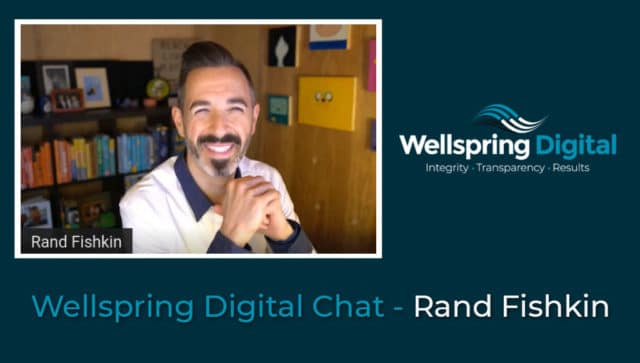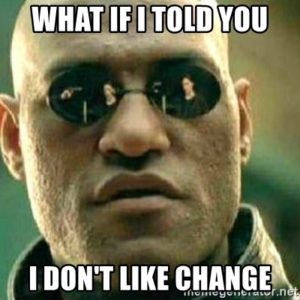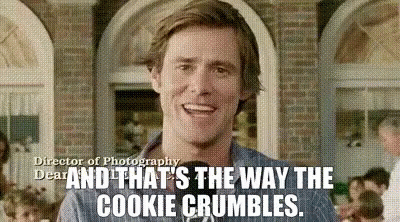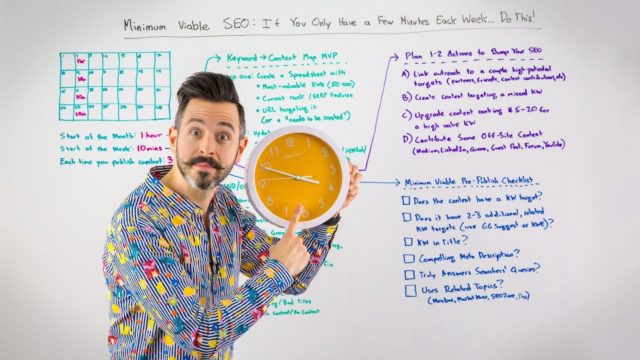If you have spent any time in digital marketing, you’ve no doubt heard the name, Rand Fishkin. He founded one of the earliest SEO tools called SEOMoz which became Moz.
He is now running SparkToro, one of the web’s best audience research tools. He is one of those marketers who falls into the “when he speaks, I listen” category. He is also a feminist, husband, and all-around great human!

We are so fortunate to have him as a guest on this episode of the Wellspring Digital Chat. I know you’ll get lots of great stuff from this one. In this one, we tackle…
- Whiteboard Fridays and SEO’s Complexity
- Getting Your Content Seen
- Is Social Media and Internet Pay to Play?
- SEO Benefits of Google E-A-T
- Privacy and the Cookie Dilemna
Let’s dive in!
Digital Transcription (Edited for Readability)
Introductions
Jon-Mikel Bailey: Hello, everyone. I am Jon-Mikel Bailey and this is the Wellspring Digital Chat where through the power of nanotechnology we’ve developed a super-secret nanorobot sort of device that we send in a care package to our guests and then the nanotechnology goes into their brain.
They have no idea it’s happening and what it does is gathers up all their useful information. It leaves a copy on the hard drive, of course. And then nanotechnology reports back to the mothership and it benefits you. No one’s hurt or harmed in any way. That was probably the longest, goofiest intro I’ve ever done.
Anyway, if you’ve ever done SEO, then you know the name, Rand Fishkin. To many in our industry, he is, dare I say, SEO royalty. To me, he is just one of the smartest, thoughtful, caring, and accessible humans on the planet. He adores his wife. If you don’t believe me, Google, “Rand Fishkin, Oprah,” and I’ll just leave that where it is.
And he is a rock in our industry. So I am happy to have him on here. Rand, please take a moment and introduce yourself to the people that don’t know you.
Rand Fishkin: Jon, thanks so much for having me. Yeah. Great to be here. So I, yeah, historically, I haven’t been in the SEO industry for many years now. But I started a company called Moz, which in its early days was a blog and website for education. Initially, a consulting company then became a software company, got venture funding.
I was the CEO for many years and Moz obviously became a relatively large sizable business with lots of customers and revenue. I left that company four years ago and started a new one called SparkToro, which is in audience research. And that company is going quite well. We’ve had a product alive for about 18 months now.
We’re a very tiny little company. It’s just myself, my co-founder, Casey (Henry), and Amanda Natividad. And yeah, the three of us are very pleased with progress so far. I also wrote a book called Lost and Founder, which is kind of about a lot of the pitfalls and challenges of the startup and venture capital worlds, as well as lots of lessons learned on marketing.
And I was the author of the original Art of SEO book, too. Yeah, and I do a lot of speaking and writing. I’m directing a video game, doing all sorts of stuff.
Jon-Mikel Bailey: Man, that sounds fun. Yeah. So you, in my mind will always be associated with SEO, and now you’re doing audience research, which I think is a critical part of SEO anyway. So I’m kind of going to take that tact with it with my questions. But anyway, I saw you…
Rand Fishkin: I just have one favor, Jon, which is, if you publicly stated SparkToro is not an SEO tool. And it does not directly help you with SEO. This is very important for me because I signed a non-compete saying that SparkToro would do nothing in the SEO world.
SPARKTORO IS NOT AN SEO TOOL!
(Cool, Moz? Thanks!)
Jon-Mikel Bailey: To all the lawyers watching SparkToro has nothing to do with SEO, a completely different ball of wax altogether. In no way does it compete with SEO tools. And if you are going to sue Rand…
So I saw your keynote at a Digital Summit. I think this was like 2017. And you were wearing what I’ll describe as a phenomenal hat at the time. A slightly political statement was made on the hat. But anyway, we won’t get into that. So, your talk was great as well and I’m really excited to dig into your marketing brain so is that alright, are you ready?
Rand Fishkin: Yeah, I love it. Was it the “Make America Gay Again?”
Jon-Mikel Bailey: Oh yes. That. Yes.
Rand Fishkin: I remember that Wil Reynolds and I went to a cupcake shop together and found these “Make America Gay Again” hats and even though obviously, neither of us are technically members of the LGBTQA community we are big supporters. And so we got matching hats.
Jon-Mikel Bailey: It was a fantastic statement. And it really made my whole trip. So, for me personally, thank you for that.
Rand Fishkin: Oh, my pleasure.
Whiteboard Fridays and SEO’s Complexity
The History of Whiteboard Fridays and the Effectiveness of Episodic Content
Jon-Mikel Bailey: So, I was talking to someone from our company about the fact that I’m interviewing you today and he asked if we could get a signed whiteboard from you. The reason for that, if anybody doesn’t know, many people know you from Whiteboard Fridays, those videos, and I do miss you in those videos. For sure. I want to start. Brilliant.
Rand Fishkin: I guess I have it because it’s hard for your nanobots to carry a whiteboard all the way over.
Jon-Mikel Bailey: Yes. I appreciate that. Yeah, we’re working on that. But um, so my first question is a two-parter. I’m trying to sneak one in here. You know, first, what was the motivation for starting to do these? And second? This is a loaded question. Do you think we can blame spammers for the fact that SEO is so complicated that we need those videos in the first place?
Rand Fishkin: Ooh, interesting. Let’s see. So the inspiration for Whiteboard Friday was very accidental, like a lot of things in my career, I kind of fell into it. I was explaining some concepts in the SEO world. This is very early on 2007-8, something like that, to a co-worker, who had gotten a camera, a video camera for another thing we were doing at the office at the time.
And he was like, hang on, hang on, let me get the video recorder. So we filmed it. And the biggest reason that we did Whiteboard Friday was because it saved me one night a week of blogging. And it was like, I could take Thursday night off. And that was a huge load off for me. At the time, I was basically blogging from 10 pm to 2 am, every night, five nights a week.
And doing that four nights a week was much more attractive. So the early Whiteboard Fridays, I don’t know if you’ve seen the early ones, Jon, they’re terrible. I know, most of them are. The video quality is bad. I have a million disfluencies. It’s just all ahs an ums. And the concepts that are explained are not done particularly well, the content isn’t always accurate.
Certainly, if you watch them now, I don’t think most of the concepts still apply. But we could see that there was some traction over time and a couple of years into it, they started performing decently well, they were always the worst-performing blog posts that we put on Moz. Really, until I think it was maybe year four, year five of Whiteboard Friday that they started to climb.
And by the time I left the company, I had stepped down as CEO and was an individual contributor for a few years there. At the time, I left the company, Whiteboard Friday was the number one performing piece of content. Huge every week. So, it’s one of those things where I think there’s a lot of value in episodic content, just in creating a brand, delivering it consistently finding an audience building up a fan base, and then delivering that over and over again.
You build up this back catalog of content that people who like one episode can go and check out more. I think that’s what podcasts do. It’s what television series do? Well, I think that’s why you see so many movies that are produced in Hollywood today that are essentially, you know, the same topic or material or universe again, and again because you can bring the fan base with you from previous ones and build up that sort of flywheel concept.
Jon-Mikel Bailey: Marvel and your Star Wars.
Rand Fishkin: Star Wars, Lord of the Rings before that, right? It’s just, you know, a lot of this stuff.
Gaming Google and the Complexity of SEO
Jon-Mikel Bailey: And so to kind of rephrase the second part of the question, why is it that SEO is so complicated that you feel like you need something like Whiteboard Friday? I mean, is it because people are constantly trying to game the system and game Google?
Rand Fishkin: In the early days, there was a lot of that. Today, I think there are certainly people who try but it’s very inefficient, and ineffective. And Google’s, even for the past 10 years, spam has just been so relatively difficult compared to doing things the right way that it’s barely worth it.
What I would say though, is, I think, the reason Search Engine Optimization was so complicated is that Google and the other search engines were competing within the early days, MSN Search, and what AOL and Yahoo, etc, etc. All of them believed that they had to be extremely secretive or spammers and web publishers would exploit their not-perfect algorithms.
And so you had this world where people are creating a system of ranking, and a system for visibility, that is becoming extraordinarily popular with human beings all over the planet or connected to the internet. They are not explaining how the systems work, intentionally obfuscating how their systems work, which creates a lot of mystery, creates a lot of intrigue, a lot of conspiracy theories, all these kinds of things.

And so, naturally, you’re going to get a large ecosystem of people experimenting and doing work to try and figure those out. And you know that Google is not a simplistic system, right? It’s a very complex system. And so you need people to explain it. Whiteboard Friday was always a distillation and an oversimplification and a lot of ways of SEO concepts. But it helps, right, it helps a lot of people.
Jon-Mikel Bailey: Google should change their tagline from “do no harm” to “intentionally obfuscating,” that’s a hard word.
Getting Your Content Seen
Jon-Mikel Bailey: So you know, there are spammers, there’s content flooding the internet, by the minute. And organic content marketing success, at this point, seems like a wistful dream. In a recent post, you talk about how hard it is to get links to your content, quality backlinks, and get your content seen you.
You often mentioned that you’d rather have one new email subscriber than 1000 followers on Facebook, which speaks volumes to me. So, you know, this is doomsday stuff, is there hope for getting content seen? And you know, what would you tell the average marketer, as far as, you know, when they’re losing their mind about never getting any kind of eyeballs on their content? I’m struggling with it.
Rand Fishkin: Yeah, a few things are true here. I don’t think this is a doomsday scenario. But I think that if you are relying on the fact that “I created good, unique content, just like it was 2009/2010, and why am I not getting traffic from Facebook and Twitter and LinkedIn, and Reddit and Google and Google News and YouTube? Like I used to? How is it possible that things are changing? I don’t like change.”

Alright, friend, I have bad news for you. The incentives of all of these monopolies, Google and Facebook and all the other players, Amazon, their goal is to do two things: one, to stop sending you traffic and start keeping traffic for themselves in every scenario that they possibly can. So you can see this very visibly in, for example, the Facebook feed I think, is one of the most obvious ones, right?
If Facebook videos yeah, sure, sure you put up a native Facebook video. And Facebook’s algorithm will show that to more people and reward engagement more than if you put up a link to YouTube, right? Even though the experience is virtually the same. Facebook wants to encourage and incentivize you to upload a native video so that you are making sure your fans and subscribers don’t leave Facebook, needing Facebook is the enemy, keeping people on Facebook is the goal.
Google is the same way. Once Google essentially achieved 95% Plus market share in every country around the world except China. Well, and Korea, then what’s happening right now Google’s growth, they have to show Wall Street growth, right. So in order to get growth, they can no longer get that growth from more people.
The planet’s you know, popular internet population is growing fast enough for them. And so they have to extract more dollars from each person who uses Google. And that means keeping people on Google in Google properties. So you know, years ago, Jon, for example, we mentioned Whiteboard Friday, the Whiteboard Friday video series, when you searched for SEO topics, you could see a link with a video clip to Whiteboard Friday.
Today, you will not see that. You will see links not to Moz’s website where the old videos are posted that I did, but to YouTube because Google wants to send all video traffic to YouTube and nowhere else. And you know, they might try and make arguments around this. But I think it’s you know, very obvious.
There’s basically one day in the summer of 2015, or something, when you know, went from like 80% or 70%, non-YouTube video links to 90% YouTube links, and you’re like, “Hey, what happened?”
Jon-Mikel Bailey: Oh, they changed it. It’s it. I’m sorry. Good, good.
Rand Fishkin: Oh, I was just gonna say, you know, in answer to the broad question, if you want the content to be seen, you have to recognize that you’re now serving, you need to serve the platform’s interests as well as your own. And so links back to your website, from Google, from Reddit, from Twitter, from YouTube, those are not going to be nearly as successful as content that is natively created for those platforms.
Where you are getting value from people experiencing that content in a native way. And so you just have to think very differently about what is content? What are the content publishing platforms, what are my goals? How do I take advantage of the opportunities that exist?
Jon-Mikel Bailey: And it seems as though, you know, is in exchange for the old way of just trying to push as many links out there and get links back to your content? It’s almost as if brand building is more important now.
Rand Fishkin: And maybe it always was?
Jon-Mikel Bailey: Yeah, good point. Good point. Absolutely. Yeah. I mean, it’s funny, you know, I’ll be hanging out with friends or something, and somebody will do a search on Google and make a comment, like, “I hate it when they don’t just show me my information right there on that first page. And it’s like, I just kind of chuckled because I’m like, yes.
Rand Fishkin: There you go. Yeah, yeah, no, Google has trained internet using human beings to hate having to click on anything. So as Facebook, so as Twitter, right, they’ve built up the association in our minds that we shouldn’t have to click to go anywhere else, all the information should be right there in the platform.
And so while Google is certainly harming the rest of the internet, and small businesses, you know, of every stripe and web publisher and doing the thing right, that they say you’re not supposed to do, which is steal the content and present it as your own. They’re definitely making their searchers happier.
So it’s a very, very tough struggle to say, you know, yes, they’re probably falling afoul of the intent of antitrust laws. But are they actually providing a service that the average consumer would say is valuable to them? Yeah, probably.
Jon-Mikel Bailey: Speaking of lawyers. I think, you know, it’s funny how certain things become so difficult, it’s so hard to click on that link to another page. If our grandparents, you know, great, great grandparents could come back, come forward in time and see the ease with which we are able to do things today, they would be like, “yes, you guys are lazy.” That’s me, not you.

Rand Fishkin: This is the hedonic treadmill of humanity, right. We are, once we get into a certain cycle into a certain way of thinking, a way of doing things, everything else seems horrible and terrible. And why do we have to do it that other way?
Jon-Mikel Bailey: Exactly.
Is Social Media and the Internet Pay to Play?
Jon-Mikel Bailey: So you know, all these platforms we were just talking about, in addition to wanting to keep all the content and the eyeballs on those platforms, they also seem to be making it harder and harder for organic content to work. And it seems almost as though these platforms are turning into strictly pay-to-play. I don’t see that completely happening. But you know, is that the future, you really have to shell out the big bucks to get seen in the future? What do you think? Or even now?
Rand Fishkin: I think that’s certainly the long-term goal of all these platforms, right. But my sense is that there’s still plenty of opportunity. I think where the most under-investment comes from marketers, is identifying publications and platforms, people, newsletters, YouTube channels, podcasts, webinars, series conferences, all these places where people where the audience you want to reach is already paying attention.
And you are ignoring them because it’s not Google or Facebook. And then we all sort of complain about it. We’re like, “Oh, it’s so hard to get my link on Google or Facebook.” And what if you put in 20% of the effort that you put into your Google rankings in trying to get into 10 of the email newsletters that go to the people who you most want to reach with your message.
I am blown away by how few people make even the tiniest attempt to even identify the sources of influence that their audiences pay attention to already, whatever kinds of publication and people and places those might be, and reach them through those sources. It is very weird. It’s almost like, you know, we have the Google of 2006, right? And in 2006 2007, there were millions of marketers around the world who are basically like Google, that spam, like doing SEO is spam. I’m not going to try and do that.
There’s no way I’m hiring anyone to do SEO, SEO is a scam. I don’t know if you remember those days, right. But every other article about SEO and certainly every mainstream publication that covered SEO until probably the 2010s wrote about it as though it were this sketchy, manipulative, crappy thing that no one should do. No serious marketers should do.
I feel I feel like that it’s come full circle, now. It’s like, okay, everybody should, you know, how do you get rankings in Google? And wait, other publications? Why would I show that stupid?
Influencer Marketing
Jon-Mikel Bailey: You know, it’s funny because it’s one of the things that frustrates me is, you know, I think there is this vast misconception about what influencer marketing actually is. And I think people are missing out, just like you alluded to that there are, you know, there are influencers and influential channels that you’d want to get be a part of, and most people hear influencer marketing and they think, you know, Instagram, celebrities, all that sort of thing.
Rand Fishkin: I have sort of decided that I’m not going to try and change the existing language. People think influencer marketing is paying half-naked people on Instagram and YouTube and Tiktok. Approach with their products and like, great, you go find that shirtless guy on a beach, who does a bunch of push-ups and, you know, have him promote your product. That’s influencer marketing, fine.
But marketing through your audience’s sources of influence, that’s a different thing. And that is a very powerful tactic, that for years, you know, PR and advertising worlds have depended on and relied on and is still extremely effective. No doubt about it. Right?
I mean, the value of I think the absolute best marketing that you can do is if you are a restaurant in Seattle, and you want to get lots and lots of business, having the eaters Best of 2022 List put you in the top 10 spots of Seattle restaurants is worth way more than every single Google keyword you could possibly rank for.
I think that is true in sector after sector after sector. And the challenge is sort of convincing marketers who are deeply focused on the tactical execution of specific channels, whether that’s PPC, or SEO, or display and retargeting advertising, and saying, “Hey, hang on, what are the business goals?”
If the business goals are X, the best way to accomplish that might be Y. And that might not be what you’re doing. Right? Can we connect these things up? And I think unfortunately, those conversations are very challenging to have because agencies, consultants, marketing teams in-house teams have structured themselves in these sort of tactical groups, and they do what they’re supposed to do.
Not what’s the strategic and tactical, most effective thing to do.
Jon-Mikel Bailey: Which is funny, because that’s not really the intent or really the reality of the internet, that things are going to work according to tactical silos within a company. So yeah, we’re all screwed. I’m just kidding.
SEO Benefits of Google E-A-T
So, you know, next week, I’m giving my first talk in a year and a half on Google E-A-T. And I want to pick your brain on that. We just talked about pay to play. I’ve been thinking, you know, is E-A-T going to be the thing that keeps content marketing a viable marketing tactic? Are there real benefits to focusing more on say E-A-T type content and campaigns and less on just simply getting eyeballs.
Rand Fishkin: I’m very excited for this question, Jon, because the answer is, I have no effing clue. And I’m really proud of that. Because I’ve been out of the SEO world for so long that to be honest, the attention I’ve paid to E-A-T, other than occasionally it coming up in my Twitter feed is basically, I don’t know, and I don’t think about it.
So to the broader question that you asked, though, around, is content marketing still a viable tactic? 1,000,000%. Yes. Right. Let me give you an example. Yesterday morning, my wife, who runs a sort of travel and personal opinion website, wrote an article about a bad restaurant experience that we had in Italy.
We had like 50 good restaurant experiences, but we have one bad, one pretty terrible. And she wrote about it. It was a very humorous review. It was very relatable. It was deeply strange. There were accompanying photographs that sort of, really told the story.
And after publication, you know, the New York Times food critic Pete wells tweeted that it was one of the best restaurant reviews of the year and Patton Oswald tweeted, the actor, and Neil Gaiman, the writer tweeted about it. All sorts of people and you know, 100 different publications from like Khaki to Boing Boing to Meta Filter, all picked it up eater wrote about it this morning.
So just you know, the Today’s show reached out. They want to interview her about it. It is doing extraordinary things for Gerald’s career, it is a single piece of content. It is not a massive amount of research. I would say you know, a couple of days of writing work went into it. But it is ludicrously powerful content marketing that was extraordinarily successful because of the quality and emotional resonance of the piece.
And that is something that works extremely well. For SparkToro this year, I’ve published fewer than 20 blog posts, probably the least I’ve published in my career in the past 20 years. And yet, SparkToro had an extraordinary year. It grew more than twice as fast as we predicted. Those content pieces, as few and as seldom as they were, were viewed by a lot of people who ended up purchasing a SparkToro subscription.
And they were effective because we had built an email audience of the right people, not a huge audience, certainly, you know, not even 100th the size of my old company with MOZ’s audience, but the right people, and those content pieces resonated with them. And they helped them see “oh, this is the value of you know, Spark Toro, and I can see what I should connect these things up.”
So I think content marketing and content overall is an incredibly powerful thing that many, many people can invest in, in all sorts of ways. Whether you’re producing, you know, TikTok videos or you’re writing blog posts about bad restaurants, or you are filming, you know, interviews with I don’t know, bearded weirdos in Seattle, it is an effective strategy.
It’s just that the distribution methodology has changed, and the way that you value and invest in the metrics and the tactics probably needs to evolve to.
Jon-Mikel Bailey: Yeah, I mean, that’s really the kind of the underlying theme of my question, which is, you know, stop obsessing over vanity metrics and eyeballs and start being real and start being more human and start producing quality content that people want to read. I mean, I think that’s the trick. That’s one of the tricks, at least in my opinion. Yeah. Yeah.
Rand Fishkin: I always worry when the advice boils down to, you know, produce high quality or quality content, I don’t want to say that like the content that has been successful for us, or this content that was successful for Geraldine or content that’s been successful for anyone is not high quality. I just don’t think it’s the quality of the content that predicts that success.
I think you can point to millions of pieces of higher quality content that have been less successful. And so I think the correlation if you were to independently grade and rank millions of pieces of content in their quality, and then you were to look at the degree to which they successfully accomplished their strategic and tactical goals. You would find a very low correlation. I don’t think Quality is the thing that predicts success. I do think there…
Jon-Mikel Bailey: I agree, I think “quality” is probably the wrong word. But maybe trying to say here.
Rand Fishkin: Yeah, I think that there are a few things that really work very well in the content realms, and they are tied to, they are not universal. They are tied to those business and metrics goals, right.
So if your goal is, I want people to know about my brand. Producing native content on the platforms that expose people to your brand is vastly better than publishing high-quality research and interactive graphs on your website that require people to link from those places, right?
That can get people to your site. But it is not a great way to get raw eyeballs, who start to see and make associations with the brand. Twitter threads or viral Facebook images, or, you know, great posts on Instagram or native video. Those are great ways to get lots of eyeballs and views. I’ve seen a lot of success.
I did the Whiteboard Friday video series, which got 10s of 1000s views watching it every week. But actually, I tell you what’s shocking is I can put a two-minute-long video on Twitter of me doing some tasks in SparkToro. And Twitter, of course, is you know, maligned by many marketers is like, oh, you can’t get traffic from Twitter.
And there’s some level. I throw all that out, right? Because I see the stats, and it’s like eight or 9000 people watch a 92nd Twitter video of just me to screen performing a marketing task. Which I couldn’t ask for better branding.
Jon-Mikel Bailey: Right. It’s relatable. And it’s helpful. And it’s it’s, and it’s native format.
Rand Fishkin: And it’s visual content. And it’s sort of interesting and creates curiosity, like, “oh, what’s he doing?” I can see it start to play, but the sound is, okay, I got to turn on the sound and see what’s going on. And it’s short enough that it engages, it’s relatable, right? It relates to something that I also do, “oh, yeah, I do need to figure out what’s the best tool to figure out competitive traffic these days.”
Alexa went away. And, you know, a whole bunch of them are, okay, what’s this similar web thing? Oh, you can see it for free. Oh, cool. Like, whatever it is. That sort of stuff, I think it is where you have to play the game. And it’s not the same for everyone. If you’re selling a CPG challenger brand, you know, the product totally different than if you’re selling B2B accounting software.
And it’s totally different if your B2B accounting software is already well known in your space, and you’re trying to improve the conversion rate. And that’s the goal versus nobody knowing about your B2B accounting software yet. And so you just have to create brand awareness. Like, it’s all got to tie together, I think this is the problem more so than one person’s content is high quality, and another person’s curate content is low quality.
Jon-Mikel Bailey: Sure, and I don’t mean to suggest that, you know, a quality written piece is always going to perform well. What I’m really trying to say is, not very well, is that I really think that it has to resonate with your audience. And it has to, they have to feel like they’ve gotten something out of it.
And you can do that by focusing on some of the sorts of tenants of EAT, or E-A-T, but it’s not the end all be all. So yeah, I think there are so many nuances. It’s almost impossible to kind of say, you need to do this. And anybody that’s telling you, “you need to do this.” You know, take it with a grain of salt.
Rand Fishkin: It’s tough. It’s tough that the answer in our field is always “It depends.” That’s the best answer. But I think it’s very frustrating because, you know, especially historically, like, I mean I’m as guilty of this as anyone. Basically saying, “Oh, well, if you follow these rules, then your content will rank in Google. And you know, and that’s the ultimate marketing goal. And hey, I was, you know, absolutely espousing that for a decade plus, so sorry about that.
Jon-Mikel Bailey: Yeah, well, no, the game has changed. Absolutely.
Privacy and the Cookie Dilemna
Jon-Mikel Bailey: And, speaking of game-changing the iOS product privacy updates seem to be giving a lot of marketers a lot of sleepless nights. We’re sort of careening towards the end of the cookie era if we haven’t already reached it. How do you see privacy updates on you know, major platforms affecting things like PPC, SEO, marketing automation?

I mean, this is a question that I seem to not be able to get an answer to. But do you think HubSpot is going to have to rethink their platform and all the other marketing automation platforms, they’re gonna have to rethink things moving forward? Or is that just sort of an unfair way of characterizing the issue?
Rand Fishkin: So remember, first-party cookies are not going away, we’re talking about third-party cookies. So this is essentially like, you know, if you visit SparkToro, and then you come back to SparkToro, I can store a cookie on your browser so that you don’t have to type in your login again.
Or I know which parts of the tool you’ve already visited, or which searches you’ve run or haven’t or, you know, whatever it is, right. So I can do that. Google can still show you personalized information, when you go to Google’s properties. Whether you’re logged in or not logged in, based on your past behavior.
The challenge is whether Google can use the cookie that it’s seen from your SparkToro visit, to personalize advertising and content to you. That’s the thing that’s going to be more difficult in the future, and not be able to use cookie technology. Much my opinion, Jon, there’s too much money at stake here, to get rid of the concept of third party.
Personalization by platforms and ad platforms in particular, Apple can do whatever they want to do, Mozilla can do whatever they want to do, Google is going to find a solution around it, Facebook’s gonna find a solution around it, Amazon’s gonna find a solution around it. That’s just how it is.

And maybe that’s browser fingerprinting. And, you know, other forms of whatever, you know, Google’s like cohorts, right? They were doing the federated list of cohorts for a while the flock thing, you know, now it’s like, oh, well, we’re gonna do something that’s even more non-transparent, but accomplishes the same goal.
My suspicion is any marketer who’s having sleepless nights about this should not worry, because the highly incentivized platform technologists at these ad platforms are going to solve it for you, because they have billions and billions of dollars at stake. And you should not generally be stressing too much about that.
I mean, a platform like HubSpot is more reliant on first party cookies than it is on third. So I’m not sure that’s going to be changing all that dramatically. Maybe there’s some impact I’m not thinking of around it. But my suspicion is that some advertising, some retargeting will get more complex, less effective and more expensive.
And will people stop doing it? No, they will not. Because the beautiful thing about advertising about you know, retargeting is, Google can basically Facebook too, right? They can basically throw millions of dollars at us every month, and we will show you no matter how relatively accurate or not that we were responsible for all the conversions that you got, right. And that’s what CMOs like to be able to bring to their boards of directors.
Jon-Mikel Bailey: Right. It’s funny, you know, it’s like, I’m not losing any sleep over it. I agree with you. 100%. I, you know, whenever there is this much money involved in something, you know, radical change is not around the corner. I mean, look at it. Well, you know, social media was supposed to save us from advertising, and did that work? No.
Rand Fishkin: Not at all. I don’t even remember that promise. But I heard that line at some point. Oh, it’s great. It’s just great. Well, it’s funny to think that I long for the days of billboards and radio ads over my feed being interrupted by these ads that seem to sort of know me for sort of sketchy product. They’re watching.
Jon-Mikel Bailey: They’re always watching, Rand. Thank you so much for doing this. There’s so much valuable stuff in here.
Rand Fishkin: My pleasure, Jon. Thank you for having me.
Jon-Mikel Bailey: I’m very much excited to get this out to the world because I think you’ve said some things that people need to hear. Oh, well, thank you so much. And that’s it. Ladies and gentlemen. Take care again.

